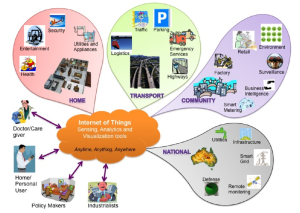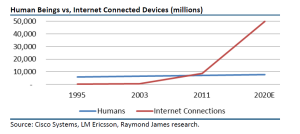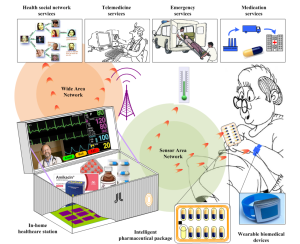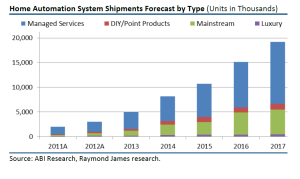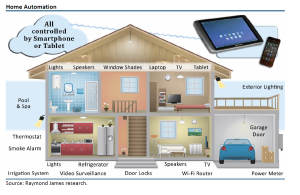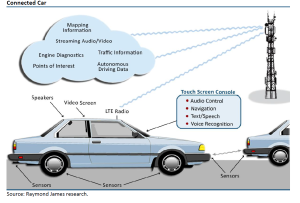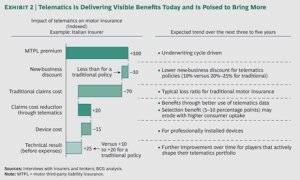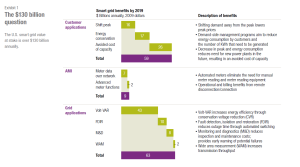The Internet of Things (IoT) has been all over the news as of late. If you’re anything like me, you’ve probably been wondering what all of the fuss is about. Today’s article will be about what the IoT is, what it can do for us, and the potential industries it can disrupt.
What is the IoT?
(credit: Deloitte University Press – Rising Tide)
The IoT is a reimagining of the function of the internet. Right now, almost all information that passes through the internet originates from a human being. In other words, human beings are the sensors for the internet. But there are fundamental problems with this approach:
1. We are terrible at acting as sensors: we are biased, we can’t make precise measurements, we lose focus easily, etc.
2. Because of our finite amount of time and energy, we are forced to prioritize what to upload to the internet.
3. We are pretty terrible at prioritizing what information is important.
4. As a result, we lose out on a tremendous amount of value that we could theoretically originate from mass connectivity.
Let me give a more concrete example:
Imagine driving your car to work in the morning. At every moment while driving you are acting as a sensor: you look at the conditions of the road, the speed limit, the cars in front of you, behind you, to your side, etc. There’s a substantial amount of information here, whether you are aware of it or not.
However, there’s no way for you (and everyone else) to upload all of this information to the internet and make use of it. There’s just too much information, too many measurements, and you are too limited in your focus / concentration / energy / ability to measure all of it.
The best you can do is prioritize your data collection and use a traffic app like Waze to give other people some idea of the traffic conditions along your route. But that is a very small amount of information compared to what’s theoretically out there.
Now imagine a different scenario…
Instead of using human being as sensors, let’s imagine that everything around you is a sensor. Your car is full of sensors that are constantly detecting the movements of every other car around you, your speed, and the amount of gas you have. The road is full of sensors so it knows exactly how many cars are on it, where they are, and how fast they are going. The air is full of sensors as well — checking for movement, traffic patterns, and exhaust.
And what do all these sensors do? They upload all of this information to the internet, where it is processed and instructions are issued to all of these sensors.
Those instructions might include things such as issuing warnings when other cars are getting too close, planning the shortest possible route for every driver, and perhaps someday directing the movements of all the cars to maximize traffic flow and prevent accidents. That’s the Internet of Things in action.
What Makes the IoT Different than Web 1.0?
1. The Hardware is Different. Our present system (which I will hereafter refer to as Web 1.0) uses mainly desktop computers, smartphones, and tablets to upload data to the internet. These things might still be important, but future sensors will be smaller and less flashy. Much of our hardware will likely be reimagined to include microscopic sensors that are connected to the net and are constantly uploading information about the environment.
2. The Number of Sensors Will Increase, Substantially. Web 1.0 has only around 1.5 billion connected devices. Web 2.0 (the IoT) is projected to have tens of billions:
3. The IoT is Focused Toward Sensing, not Communication. Web 1.0 was all about allowing people to communicate with each other (Blogs, Facebook, Twitter, etc.). The IoT (aka Web 2.0) will be about sensing the environment, collecting data, uploading it, processing it, and generating value from it.
What Can the IoT be Used For?
According to a Bain & Company study, the IoT could attract up to $1.4 trillion investment in the next 4 years (and Cisco estimates it could produce up to $14.4 trillion in economic value over the next decade).
The IoT could potentially affect every industry, but for the sake of time I’m going to focus on just a few interesting ideas:
1. Wireless Health Care Sensors
2. Smart Homes / Home Automation
3. Wireless Automotive Integration and Telematics
4. The Smart Grid
Wireless Health Care Sensors
(credit: Bain & Company)
Wireless health care sensors can save us up to $2,600 per person per year (~$800 billion) through:
1. Delivery Systems Optimization. Providers could better track the efficacy of their treatments (which is extremely difficult in the Web 1.0 era). With the IoT providers can look at how patients are doing after surgery or medication and use this to better determine when certain operations are necessary.
One example is Knee Arthroscopy Surgery – there are over 650,000 of these operations every year in the U.S. alone. However, present data shows that 44% of these operations are not necessary, and may even make things worse.
Potentially, with access to Web 2.0’s sensor technology health care providers could better figure out which treatments work best in each cases, and thus improve health care quality and reduce spending for all.
2. Management of High Cost Patients. The IoT will allow health care providers to better track high risk patients. Sensors could track things such as heart rate, respiration, blood pressure, blood glucose, if the patient took their medicine, etc. This would allow health care providers to identify problems before they happen.
An example might be, if a patient with a heart condition starts experiences irregularities in their heartbeat the health care provider could detect this and ask them to come in for a check up. The patient could be put on medication and monitored in the hospital, preventing a heart attack and saving an enormous amount of money for the patient and his / her family.
3. Administrative Efficiency. Part of administrative cost savings come from electronic health records (EHR), which save time and effort that can be spent on patient care.
More relevant to the IoT is the data that is stored on EHRs. Because of the increased amount of available data, medical device, pharmaceutical, and medical equipment manufacturers can better target their R&D programs to specific ailments and patient segments.
Here are some of the other ways the IoT could transform health care:
(credit: Raymond James Research)
Smart Homes
(credit: Raymond James Research)
Home automation technology has been around for a very long time, but has been the domain of the very rich. However, according to consumer research (see above) that’s about to change.
In a nutshell, home automation is being able to manage all of the electronics in your home to maximize comfort and minimize electricity, maintenance, and replacement costs.
Let’s talk about some examples:
(credit: Raymond James Research)
1. Thermostats that manage your home’s heating schedule to save you money on your heating bill and keep you comfortable.
2. Refrigerators that know when they’re empty, contact you to refill them, and manage the temperature inside themselves to save energy / minimize cooling costs.
3. Locks that recognize you and unlock themselves, but can alert the authorities if they are forced upon by an outsider.
4. Lights that turn on and stay on when you enter the room, turn off when you fall asleep, and modify themselves to the level of lighting you need.
5. Mirrors that incentivize you to do things, like brush your teeth or shave.
The options are pretty limitless here. And that’s why Google recently acquired Nest, which designs smart thermostats and smoke detectors.
Wireless Automotive Integration
(credit: Raymond James Research)
Wireless automotive technology could include things such as self driving cars in the long term (as we already discussed), and in the short term, telematics.
Telematics use GPS and other wireless technology to track your car’s movements and your driving behavior. As you might imagine, this information could be used by insurers to more accurately price your auto insurance premiums.
Insurers could use data about the speed you travel, the routes you take, how quickly you accelerate, how frequently you drive, etc. to lower insurance premiums for safer drivers. As a result they could attract safer drivers, reduce the number of claims they have to process, and gain a cost advantage over competitors.
For example, BCG conducted a study that showed that Telematics technology can improve the margin for insurers anywhere between 5-15%:
Although more than 70 insurers offer telematics services worldwide, the penetration rate is around 1%. However, the interest is there.
Italian insurers expect the penetration rate to rise to 10-13% in the next few years, and UK insurers predict the penetration rate to rise to 7-10% in the next few years as well. Japanese automakers are even installing telematics technology in their new vehicles in preparation for a rise in demand.
The Smart Grid
The smart grid is basically just connecting the entire electricity grid wirelessly and using the data to better manage electricity flow, better manage pricing, reduce capacity, and reduce the cost of measuring consumer usage. Let’s get into more specifics:
According to estimates by McKinsey, a fully deployed smart grid could generate as much as $130 billion in value annually. The value comes from three areas:
1. Customer Applications. Basically, utilities companies will be able to provide customers more real time data about pricing and their usage. For example, utilities can shift pricing to be based on demand and give customers a real time estimate of using electricity now vs. nonpeak hours.
This would incentivize customers to use electricity more at nonpeak hours, and in turn reduce the amount of capacity electricity companies need at peak times during the day and the year.
2. Advanced Metering Infrastructure (AMI). Wireless meters don’t require someone to go check on how much electricity is used in a given year, saving on labor costs for the utilities companies. Additionally, it will let utilities companies know immediately when and where an outage has occurred.l
3. Grid Applications. This includes things like more exact control of the voltage to reduce power loss, the ability to reconfigure the grid remotely in event of problems, allow more accurate measurement of unused capacity, and detection of problems before they happen.
Conclusion
The Internet of Things (IoT) is a reimagining of the internet. The role of the sensor, once exclusively populated by human beings, will be shifted toward mobile devices, RFID tags, and other pieces of hardware.
The IoT is expected to attract $1.4 trillion in investment over the next 4 years and generate $14.4 trillion in value over the next decade.
Much of that value comes from cost savings (in energy usage, for example) but also our improved ability to track efficacy of things such as surgeries, drugs, and even our own driving.
Further articles will go deeper into some of the areas of the IoT that we did not discuss, such as the future of mobile devices, big data analytics, connectivity services, and the like.
